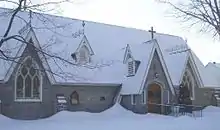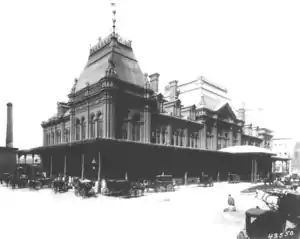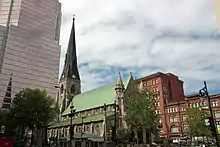Thomas Seaton Scott | |
|---|---|
| Born | 16 August 1826 |
| Died | 15 or 16 June 1895 Ottawa, Ontario, Canada |
| Nationality | Canadian |
| Occupation | Architect |
| Practice | Chief Dominion Architect |
| Buildings | Union Station, Parliament of Canada, Cartier Square Drill Hall |
Thomas Seaton Scott (16 August 1826 – 15 or 16 June 1895) was an English-born Canadian architect. Born in Birkenhead, England he immigrated to Canada as a young man first settling in Montreal. He was hired by the Grand Trunk Railway and worked for them on a number of structures including the Union Station in Toronto and Bonaventure Station in Montreal.
In 1871 he was hired by the Department of Public Works and he designed a number of Ottawa's new government buildings in the years after Canadian Confederation. Among his works are the West Block of the Parliament of Canada, the Cartier Square Drill Hall, and the now demolished Dominion Post Office. From 1872 to 1881 he held the position of Chief Dominion Architect and thus played at least a supervisory role in all major government projects. He is considered one of the creators of the Dominion Style that dominated Canadian institutional architecture in the nineteenth century. He was a founding member of the Royal Canadian Academy of Arts[1] He was succeeded as Chief Architect by Thomas Fuller.
Works
| Building | Year Completed | Builder | Style | Location | Image St Luke's Church | Notes |
|---|---|---|---|---|---|---|
| Aurora Armoury | 1874 | Thomas Seaton Scott | Dominion Style Neo-Gothic style | 89 Mosley Street at Larmont Street, Aurora, Ontario | Still in use by the military. | |
| Mackenzie Tower, West Block | 1878 | Thomas Seaton Scott | Parliament Hill, Ottawa, Ontario | Provided design in 1874 | ||
| Second Supreme Court of Canada building | 1874 | Thomas Seaton Scott | Gothic Revival architecture | Demolished 1955–56 and now parking lot | ||
| Cartier Square Drill Hall | 1879–80 | Thomas Seaton Scott | Dominion Style Neo-Gothic style | 2 Queen Elizabeth Driveway, Ottawa, Ontario |  |
Still in use. |
| Truro Armoury | 1874 | Thomas Seaton Scott | Dominion Style Neo-Gothic style | 126 Willow Street, Truro, Nova Scotia | Still in use. | |
| St. Bartholomew's Anglican Church (Ottawa) | 1868 | Thomas Seaton Scott | Dominion Style Neo-Gothic style | 125 MacKay Street, Rideau-Rockcliffe Ottawa, Ontario |  |
Still in use. |
| Summer House/Summer Gazebo, Parliament Hill | 1877 | Thomas Seton Scott | Carpenter Gothic | Parliament Hill, Ottawa, Ontario | Built for the Speaker of the House of Commons and demolished 1956. It was re-built in 1995 on the same location.[2] | |
| Toronto Union Station (1873) expansion | 1888 | Thomas Seaton Scott with Edward P. Hannaford | Dominion Style Italianate /2nd Empire style | Approximately at 7 Station Street, Toronto, Ontario |  |
Demolished 1927–1931 and now site of Skywalk c. 1989 |
| Grand Trunk Railway, Bonaventure Station | 1888 | Thomas Seaton Scott with Edward P. Hannaford | Dominion Style Neo-Gothic style | Near corner of rue Peel and rue Saint-Jacques, on Chaboillez Square, Montreal, Quebec |  |
Heavily damaged by fire 1916, but remained standing until 1952. Now site of Dow Planetarium |
| Christ Church Cathedral (Montreal) | Dominion Style Neo-Gothic style | Thomas Seaton Scott | Gothic Revival | 635 rue Saint Catherine Street Ouest, Montreal, Quebec |  |
|
| St. Luke's Anglican Church, Waterloo QC | 1870 | Thomas Seaton Scott | Neo-Gothic style | 400 rue de la Cour, Waterloo, Quebec | _iso.jpg.webp) |
Other buildings designed by Scott include:[3]
- houses for Edward Prentice on Bleury Street in Montreal 1858
- St. John's Anglican Church 490 Centre Street, Prescott, Ontario 1858–60
- residence for Thomas Mussen, Sherbrooke Street West near Bleury Street, Montreal 1859
- villa for Peter Robertson on Redpath Street, Montreal 1859
- Erin Cottage for James E. Major on Guy Street near Dorchester Street West, Montreal 1859
- Cathedral School House, Anglican Cathedral, Burnside Place at University Street, Montreal 1860
- Lumberman's Royal Arch for the Prince of Wales, Ottawa, Ontario 1860
- Ballymena residence for Rev. Richard Lewis, Maitland, Ontario 1863
- Rosemount villas for Robert J. Reekie, Rosemount Avenue, Montreal 1863
- Richmond Railway Station, Richmond, QC 1863; burned down 1883
- Rowhouses for Edward G. Penny, St. Nicholas Tolentine Street, near Dorchester Street West, Montreal 1864
- Thomas Mussen store on Notre Dame Street at St. Lambert Street store for Thomas Mussen, Montreal 1865
- Murray Bay Protestant Church, Murray Bay, QC 1867
- Bishop Strachan Memorial Anglican Church, Cornwall, Ontario 1869–75; now Trinity Anglican Church
- St. Mark's Presbyterian Church, William Street, Montreal (Griffintown), 1869–70; demolished 1925?
- Additions to Cornwall Court House & Gaol, Pitt Street, Cornwall, Ontario 1869
- Grace Anglican Church, Wellington Street Montreal, 1870–71
- Rideau Cottage, Ottawa, 1872 renovations
External links
References
- ↑ Records of the Founding of the Royal Canadian Academy of the Arts. Toronto: Globe Printing Co. 1879–80. p. 16. ISBN 978-0-665-13296-4.
- ↑ "House of Commons Procedure and Practice – 6. The Physical and Administrative Setting – the Parliament Buildings and Grounds".
- ↑ "Archived copy". Archived from the original on 2014-10-27. Retrieved 2014-10-28.
{{cite web}}: CS1 maint: archived copy as title (link)